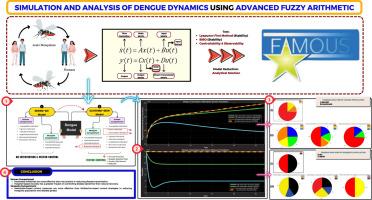基于高级模糊算法的登革热传播动力学模拟与分析
IF 3.2
3区 环境科学与生态学
Q2 ECOLOGY
引用次数: 0
摘要
由于伊蚊的广泛存在,登革热仍然是马来西亚的一个主要公共卫生问题。因此,对其传播进行建模是必要的。本研究旨在对传统的SIR-SI模型进行改进,建立SEIHRD-SEI和SAVEIHRD-SEIW两种模型,利用基于转换方法的高级模糊算法建模准确表征登革热传播。这些增强的模型纳入了诸如提醒意识、接种疫苗和病媒控制等干预策略。在Simulink中对SEIHRD-SEI和SAVEIHRD-SEIW的状态空间模型进行了仿真,并采用矩阵指数积分因子法对其微分方程组进行了解析求解,得到了保持基本动力学特性的输出方程。然后使用FAMOUS软件进行高级模糊算法分析。结果表明,在人群中,意识提醒比疫苗接种更有影响力。此外,住院康复对疾病动态的影响大于自然康复。在蚊子种群中,杀虫剂的使用比沃尔巴克氏体的流行更有影响。总体而言,该研究成功地确定了最具影响力的参数。本文章由计算机程序翻译,如有差异,请以英文原文为准。

Simulation and analysis of dengue transmission dynamics using advanced fuzzy arithmetic
Dengue fever remains a major public health concern in Malaysia due to the widespread presence of Aedes mosquitoes. Therefore, modeling its transmission is essential. This study aims to enhance the traditional SIR-SI model by developing two new versions called SEIHRD-SEI and SAVEIHRD-SEIW models to accurately represent Dengue transmission using advanced fuzzy arithmetical modeling based on the transformation method. These enhanced models incorporate intervention strategies such as awareness reminders, vaccination, and vector control. The state-space models of SEIHRD-SEI and SAVEIHRD-SEIW are simulated in Simulink, and their systems of differential equations are analytically solved using the matrix exponential integrating factor method to obtain output equations that preserve essential dynamics. The simulations are then executed using FAMOUS software for advanced fuzzy arithmetical analysis. The result shows that awareness reminders are more influential than vaccination in the human population. Furthermore, hospitalized recovery has a greater influence on disease dynamics than natural recovery. In the mosquito population, insecticide usage is more influential than Wolbachia prevalence. Overall, the study successfully identifies the most influential parameters.
求助全文
通过发布文献求助,成功后即可免费获取论文全文。
去求助
来源期刊

Ecological Modelling
环境科学-生态学
CiteScore
5.60
自引率
6.50%
发文量
259
审稿时长
69 days
期刊介绍:
The journal is concerned with the use of mathematical models and systems analysis for the description of ecological processes and for the sustainable management of resources. Human activity and well-being are dependent on and integrated with the functioning of ecosystems and the services they provide. We aim to understand these basic ecosystem functions using mathematical and conceptual modelling, systems analysis, thermodynamics, computer simulations, and ecological theory. This leads to a preference for process-based models embedded in theory with explicit causative agents as opposed to strictly statistical or correlative descriptions. These modelling methods can be applied to a wide spectrum of issues ranging from basic ecology to human ecology to socio-ecological systems. The journal welcomes research articles, short communications, review articles, letters to the editor, book reviews, and other communications. The journal also supports the activities of the [International Society of Ecological Modelling (ISEM)](http://www.isemna.org/).
 求助内容:
求助内容: 应助结果提醒方式:
应助结果提醒方式:


